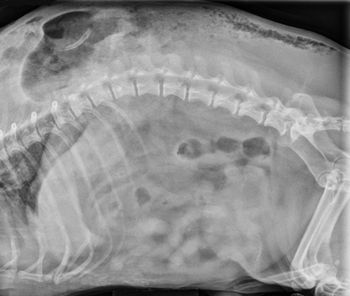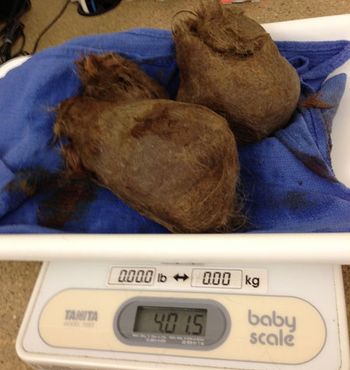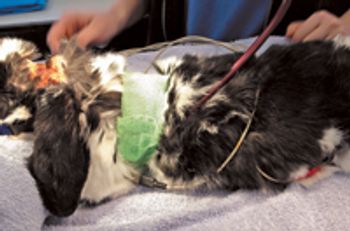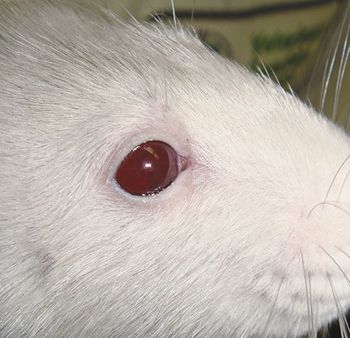
Correct answer: Image Quiz: A Chihuahua with traumatic bite wounds

Correct answer: Image Quiz: A Chihuahua with traumatic bite wounds

Dr. Lori Corriveau shares the common mistakes veterinary practitioners make when dealing with exotic pets.

Devoicing and debeaking are complex veterinary surgical procedures performed on roosters to keep them from making noise and fighting. Dr. Eric Klaphake offers his views on these techniques and how to explain them to clients.

A practitioner's quick reference to parasiticides in dogs and cats (PDF)

Ingested fur proved too large to remove by scope.

A way to make sure your stethoscope stays out of the way during anesthetic monitoring.

These photos show how a team of 10 veterinarians successfully completed an experimental skull surgery on a green sea turtle.

What's behind the tearing and irritation in this rat's eye?

Dr. Juliet Gionfriddo helps find the cause of Lucky Duck's eye matter.

Respiratory disease in small exotic mammals is caused by a variety of etiologies but infectious causes predominate. Both upper and lower airway disease is seen and in rabbits and rodents, animals that are obligate nasal-breathers, upper respiratory disease can be as problematic as lower airway disease.

Emergency critical care and subsequent nursing care can mean the difference between life and death for a beloved pet. Critical care is an integral part of emergency management of disease in zoological species. A high mortality rate is inherent in exotic animal emergency medicine.

More and more people in todays society are choosing to own exotic pets in addition to or in lieu of the traditional dogs and cats commonly seen in private veterinary practice. Their small size and housing, ease of care, and human-animal bond potential make them the ideal pets.

Psittacine breeding has developed to fill the large demand for pet parrots created by the ban on importation. Many breeding pairs of birds are maintained in aviaries specifically to produce chicks for sale as pets.

Rabbits and rodents belong to the orders Lagomorpha and Rodentia respectively. Rodents are further divided into the suborders Myomorpha (rats, mice, gerbils, and hamsters), Caviomorpha (guinea pigs and chinchillas), and Sciuromopha (squirrels, chipmunks, and prairie dogs).

Soft tissue surgery is commonly performed on small exotic mammals for preventative health, control of reproduction, and to manage conditions warranting surgical intervention. The principles of surgery for dogs and cats also apply to cases involving exotic pets.

Providing veterinary care to exotic pets is challenging and rewarding, offering the veterinary technician the chance to work with a wide variety of species. There is an inherent challenge for those working with these pets given the large variety of species presented for care.

There are thousands of reptile species worldwide and more reptile species are kept as pets than any other taxa. For as many types of reptiles that are kept, there are as many natural history strategies that these species demonstrate in their wild habitat.

For a veterinary technician overseeing an avian or exotic animal patient, diagnostic testing is an essential tool in formulating a definitive diagnosis, prognosis and treatment plan. Diagnostic testing is simply not a luxury for veterinary teaching hospitals, but a necessity for every clinical practice that sees these patients.

Urinary diseases are frequently encountered in exotic animal pets and an understanding of the renal physiology and pathology of these diseases is important for effective treatment.

One of the most common avian presentations at our veterinary hospital is the predator attack. These cases often present with severe lacerations, limb amputations and crushing injuries.

When developing a fluid therapy protocol it is incumbent upon the veterinarian to understand what the best products to use are and why in order to achieve the best physiologic response. Unfortunately, there is a paucity of scientifically based information regarding the underlying assessment parameters for fluid therapy protocol in individual avian species.

The first condition a veterinarian must consider when a case presents for abnormal feather loss is whether the feather loss is normal.

Treating dermal injuries, fracture stabilization, stabilization of fracture sites after internal orthopedic repair, joint injuries and prevention of self trauma are common reasons bandages are used on avian patients.

It is a clinical challenge when veterinarians have to administer therapeutic procedures to pet avian patients. The thoughtful use of therapeutic procedures on a debilitated patient is often correlated to the success or failure of treating a patient.

There are many therapeutic options open to veterinarians when treating patients. Unfortunately, as case numbers increase treatment options are narrowed due to different reasons.